Related Research Articles

In biological phylogenetics, a clade, also known as a monophyletic group or natural group, is a grouping of organisms that are monophyletic – that is, composed of a common ancestor and all its lineal descendants – on a phylogenetic tree. In the taxonomical literature, sometimes the Latin form cladus is used rather than the English form. Clades are the fundamental unit of cladistics, a modern approach to taxonomy adopted by most biological fields.

Darwinism is a theory of biological evolution developed by the English naturalist Charles Darwin (1809–1882) and others, stating that all species of organisms arise and develop through the natural selection of small, inherited variations that increase the individual's ability to compete, survive, and reproduce. Also called Darwinian theory, it originally included the broad concepts of transmutation of species or of evolution which gained general scientific acceptance after Darwin published On the Origin of Species in 1859, including concepts which predated Darwin's theories. English biologist Thomas Henry Huxley coined the term Darwinism in April 1860.
Neoteny, also called juvenilization, is the delaying or slowing of the physiological, or somatic, development of an organism, typically an animal. Neoteny is found in modern humans compared to other primates. In progenesis or paedogenesis, sexual development is accelerated.
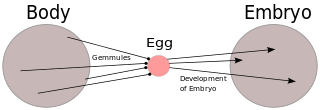
Pangenesis was Charles Darwin's hypothetical mechanism for heredity, in which he proposed that each part of the body continually emitted its own type of small organic particles called gemmules that aggregated in the gonads, contributing heritable information to the gametes. He presented this 'provisional hypothesis' in his 1868 work The Variation of Animals and Plants Under Domestication, intending it to fill what he perceived as a major gap in evolutionary theory at the time. The etymology of the word comes from the Greek words pan and genesis ("birth") or genos ("origin"). Pangenesis mirrored ideas originally formulated by Hippocrates and other pre-Darwinian scientists, but using new concepts such as cell theory, explaining cell development as beginning with gemmules which were specified to be necessary for the occurrence of new growths in an organism, both in initial development and regeneration. It also accounted for regeneration and the Lamarckian concept of the inheritance of acquired characteristics, as a body part altered by the environment would produce altered gemmules. This made Pangenesis popular among the neo-Lamarckian school of evolutionary thought. This hypothesis was made effectively obsolete after the 1900 rediscovery among biologists of Gregor Mendel's theory of the particulate nature of inheritance.

Sir William Crookes was a British chemist and physicist who attended the Royal College of Chemistry, now part of Imperial College London, and worked on spectroscopy. He was a pioneer of vacuum tubes, inventing the Crookes tube which was made in 1875. This was a foundational discovery that eventually changed the whole of chemistry and physics.
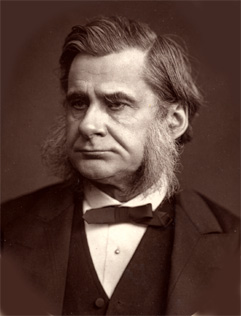
Thomas Henry Huxley was an English biologist and anthropologist who specialized in comparative anatomy. He has become known as "Darwin's Bulldog" for his advocacy of Charles Darwin's theory of evolution.
In biology, taxonomy is the scientific study of naming, defining (circumscribing) and classifying groups of biological organisms based on shared characteristics. Organisms are grouped into taxa and these groups are given a taxonomic rank; groups of a given rank can be aggregated to form a more inclusive group of higher rank, thus creating a taxonomic hierarchy. The principal ranks in modern use are domain, kingdom, phylum, class, order, family, genus, and species. The Swedish botanist Carl Linnaeus is regarded as the founder of the current system of taxonomy, as he developed a ranked system known as Linnaean taxonomy for categorizing organisms and binomial nomenclature for naming organisms.
Biological determinism, also known as genetic determinism, is the belief that human behaviour is directly controlled by an individual's genes or some component of their physiology, generally at the expense of the role of the environment, whether in embryonic development or in learning. Genetic reductionism is a similar concept, but it is distinct from genetic determinism in that the former refers to the level of understanding, while the latter refers to the supposedly causal role of genes. Biological determinism has been associated with movements in science and society including eugenics, scientific racism, and the debates around the heritability of IQ, the basis of sexual orientation, and sociobiology.

The modern synthesis was the early 20th-century synthesis of Charles Darwin's theory of evolution and Gregor Mendel's ideas on heredity into a joint mathematical framework. Julian Huxley coined the term in his 1942 book, Evolution: The Modern Synthesis. The synthesis combined the ideas of natural selection, Mendelian genetics, and population genetics. It also related the broad-scale macroevolution seen by palaeontologists to the small-scale microevolution of local populations.

Natural history is a domain of inquiry involving organisms, including animals, fungi, and plants, in their natural environment, leaning more towards observational than experimental methods of study. A person who studies natural history is called a naturalist or natural historian.
Ecological genetics is the study of genetics in natural populations. It combines ecology, evolution, and genetics to understand the processes behind adaptation.
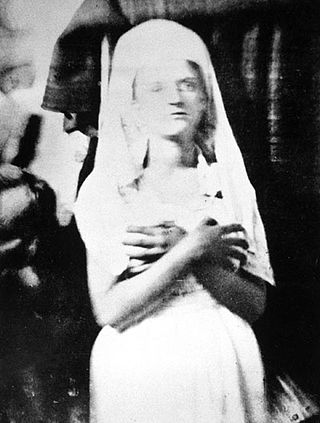
Katie King was the name given by Spiritualists in the 1870s to what they believed to be a materialized spirit. The question of whether the spirit was real or a fraud was a notable public controversy of the mid-1870s.

Florence Eliza Cook was a medium who claimed to materialise a spirit, "Katie King". The question of whether the spirit was real or a fraud was a notable public controversy of the mid-1870s. Her abilities were endorsed by Sir William Crookes but many observers were skeptical of Crookes's investigations, both at the time and subsequently.
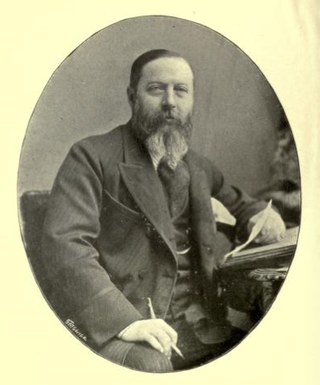
William Stainton Moses was an English cleric and spiritualist medium. He promoted spirit photography and automatic writing, and co-founded what became the College of Psychic Studies. He resisted scientific examination of his claims, which have generally been demolished.
An organism is defined in a medical dictionary as any living thing that functions as an individual. Such a definition raises more problems than it solves, not least because the concept of an individual is also difficult. Many criteria, few of them widely accepted, have been proposed to define what is an organism. Among the commonest is that an organism has autonomous reproduction, growth, and metabolism. This would exclude viruses, despite that fact that they evolve like organisms. Other problematic cases include colonial organisms; a colony of eusocial insects is organised adaptively, and has germ-soma specialisation, with some insects reproducing, others not, like cells in an animal's body. The body of a siphonophore, a jelly-like marine animal, is composed of organism-like zooids, but the whole structure looks and functions much like an animal such as a jellyfish, the parts collaborating to provide the functions of the colonial organism.

Evolutionary thought, the recognition that species change over time and the perceived understanding of how such processes work, has roots in antiquity—in the ideas of the ancient Greeks, Romans, Chinese, Church Fathers as well as in medieval Islamic science. With the beginnings of modern biological taxonomy in the late 17th century, two opposed ideas influenced Western biological thinking: essentialism, the belief that every species has essential characteristics that are unalterable, a concept which had developed from medieval Aristotelian metaphysics, and that fit well with natural theology; and the development of the new anti-Aristotelian approach to modern science: as the Enlightenment progressed, evolutionary cosmology and the mechanical philosophy spread from the physical sciences to natural history. Naturalists began to focus on the variability of species; the emergence of palaeontology with the concept of extinction further undermined static views of nature. In the early 19th century prior to Darwinism, Jean-Baptiste Lamarck (1744–1829) proposed his theory of the transmutation of species, the first fully formed theory of evolution.
Tim Lewens is a professor in the history and philosophy of biology, medicine, and bioethics at the Department of History and Philosophy of Science at the University of Cambridge. Lewens is a Fellow of Clare College, where he serves as Director of Studies in Philosophy and he is a member of the academic staff and lecturer in the Department of History and Philosophy of Science (HPS).
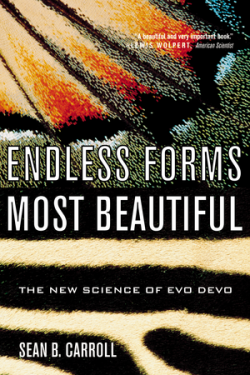
Endless Forms Most Beautiful: The New Science of Evo Devo and the Making of the Animal Kingdom is a 2005 book by the molecular biologist Sean B. Carroll. It presents a summary of the emerging field of evolutionary developmental biology and the role of toolkit genes. It has won numerous awards for science communication.
The Dana expeditions were four Danish research expeditions from 1920 to 1930. The first two were undertaken by the Dana I and the third by the Dana II. They were funded in part by the Carlsberg Foundation and led by Johannes Schmidt. The first three expeditions took place from 1920 to 1922 and the fourth and final was from 1928 to 1930. They centered around investigating the breeding of eels. The first two expeditions allowed Schmidt to prove his theory that European eels migrate to the Sargasso Sea to spawn. The final expedition traveled to the Indian Ocean and gathered numerous samples.

Clarence E Willard was an American vaudeville performer. After carrying out stretching exercises, Willard found he was able to increase his height at will by 7+1⁄2 inches (19 cm) and also elongate his arms and legs. He developed this into a freak show act under the name "The Man Who Grows". From around 1910 Willard performed in vaudeville in the United States and was also claimed to have performed at the Berlin Wintergarten theatre. He became associated with Robert Ripley, performing at the Believe It or Not! odditoriums and appearing in a short film. Willard appeared at the 1936–37 Great Lakes Exposition in Cleveland, Ohio, and later ran a restaurant in Alameda, California.
References
- ↑ "Sherrie Lynne Lyons". Alibris.
- ↑ "Species, Serpents, Spirits, and Skulls". State University of New York Press.
- ↑ Jones, Greta. (2011). Review of Sherrie Lynne Lyons Species, Serpents, Spirits and Skulls: Science at the Margins in the Victorian Age. Journal of British Studies 50: 1022-1023.
- ↑ Pearl, Sharrona. (2010). Species, Serpents, Spirits, and Skulls: Science at the Margins in the Victorian Age, by Sherrie Lynne Lyons. Victorian Studies . Vol. 53, No. 1, pp. 141-143.
- ↑ Codella, Sylvio G. (2000-10-01). ""Not Just Darwin's Bulldog"". BioScience. 50 (10): 914–916. doi: 10.1641/0006-3568(2000)050[0914:NJDSB]2.0.CO;2 . ISSN 0006-3568.
- ↑ Ghiselin, Michael T. (2001). "Review of Thomas Henry Huxley: The Evolution of a Scientist". History and Philosophy of the Life Sciences. 23 (2): 309–310. ISSN 0391-9714. JSTOR 23332324.
- ↑ Zarpentine, Chris (2013). "Nothing makes sense except in light of evolution". Metascience. 22 (2): 343–346. doi:10.1007/s11016-012-9739-1. S2CID 254792428.
- ↑ Carlson, Elof Axel (2021). "From Cells to Organisms: Re-envisioning Cell Theory". The Quarterly Review of Biology. 96 (2): 151. doi:10.1086/714473. S2CID 236373872.